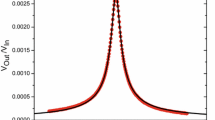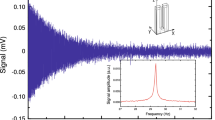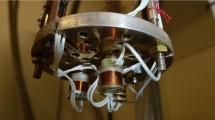Abstract
The results of a newly developed pulse-demodulation (P-D) technique introduced to determine the resonant characteristics of a high Q value quartz tuning forks in vacuum and millikelvin temperature range are presented. Applying P-D technique to a standard 32 kHz quartz tuning fork with extremely low excitation energy of the order of a few femtojoules, we were able to measure the resonance frequency of the fork’s decay signal with resolution better than 10 \(\upmu \)Hz. Using this highly sensitive measurement technique, we found a continuous and reproducible temperature dependence of the tuning fork’s resonance frequency in the millikelvin temperature range. The observed dependence suggests a potential application for the quartz tuning forks to be used as thermometers in the millikelvin temperature range. We also discuss the physical origin of the observed phenomenon.




Similar content being viewed by others
References
D.O. Clubb et al., J. Low Temp. Phys. 136, 1 (2004). doi:10.1023/B:JOLT.0000035368.63197.16
R. Blaauwgeers et al., J. Low Temp. Phys. 146, 537 (2007). doi:10.1007/s10909-006-9279-4
M. Blažková et al., J. Low Temp. Phys. 150, 525 (2008). doi:10.1007/s10909-007-9587-3
D.I. Bradley, M. Človečko, E. Gažo, P. Skyba, J. Low Temp. Phys. 152, 147 (2008). doi:10.1007/s10909-008-9815-5
D.I. Bradley et al., J. Low Temp. Phys. 156, 116 (2009). doi:10.1007/s10909-009-9901-3
D.I. Bradley et al., J. Low Temp. Phys. 157, 476 (2009). doi:10.1007/s10909-009-9982-z
M. Blažková et al., J. Low Temp. Phys. 148, 305 (2007). doi:10.1007/s10909-007-9389-7
A.P. Sebedash, J.T. Tuoriniemi, E.M.M. Pentti, A.J. Salmela, J. Low Temp. Phys. 150, 181 (2008). doi:10.1007/s10909-007-9535-2
E.M.M. Pentti, J.T. Tuoriniemi, A.J. Salmela, A.P. Sebedash, J. Low Temp. Phys. 150, 555 (2008). doi:10.1007/s10909-007-9583-7
I.A. Gritsenko et al., J. Low Temp. Phys. 158, 450 (2010). doi:10.1007/s10909-009-9950-7
V.B. Efimov, D. Garg, O. Kolosov, P.V.E. McClintock, J. Low Temp. Phys. 158, 456 (2010). doi:10.1007/s10909-009-0026-5
M. Človečko et al., J. Low Temp. Phys. 162, 669 (2011). doi:10.1007/s10909-010-0330-0
J. Rychen et al., Rev. Sci. Instrum. 70, 2765 (1999). doi:10.1063/1.1149842
R.D. Grober et al., Rev. Sci. Instrum. 71, 2776 (2000). doi:10.1063/1.1150691
Y. Seo, P. Cadden-Zimansky, V. Chandrasekhar, Appl. Phys. Lett. 87, 103103 (2005). doi:10.1063/1.2037852
A. Castellanos-Gomez, N. Agraït, G. Rubio-Bollinger, Nanotechnology 20, 215502 (2009). doi:10.1088/0957-4484/20/21/215502
K.L. Ekinci, M.L. Roukes, Rev. Sci. Instrum. 76, 061101 (2005). doi:10.1063/1.1927327
E. Collin, Yu.M. Bunkov, H. Godfrin, Phys. Rev. B 82, 235416 (2010). doi:10.1103/PhysRevB.82.235416
M. Človečko et al., J. Low Temp. Phys. 175, 449 (2014). doi:10.1007/s10909-013-0936-0
M. Sansa et al., Nature Nanotechnol. 11, 552 (2016). doi:10.1038/nnano.2016.19
L.G. Remus, M.P. Blencowe, Y. Tanaka, Phys. Rev. B 80, 174103 (2009). doi:10.1103/PhysRevB.80.174103
B.H. Schneider et al., Nat. Commun. 5, 5819 (2014). doi:10.1038/ncomms6819
O. Maillet et al., New J. Phys. 18, 073022 (2016). doi:10.1088/1367-2630/18/7/073022
B. Cowan, Nuclear Magnetic Resonance and Relaxation (Cambridge University Press, Cambridge, 2005), p. 55
P. Skyba, J. Low Temp. Phys. 160, 219 (2010). doi:10.1007/s10909-010-0189-0
S. Holt, P. Skyba, Rev. Sci. Instrum. 83, 064703 (2012). doi:10.1063/1.4725526
I.G. Main, Vibrations and Waves in Physics, 2nd edn. (Cambridge University Press, Cambridge, 1984), p. 35
J. Tersoff, Phys. Rev. Lett. 52, 465 (1984). doi:10.1103/PhysRevLett.52.465
L.D. Landau, E.M. Lifshitz, Theory of Elasticity. 3rd English edn. Revised and Enlarged (Pergamon Press, Oxford, 1986), p. 99
M. Born, K. Huang, Dynamical Theory of Crystal Lattices (Clarendon Press, Oxford, 1962), p. 322
B.K. Ridley, Quantum Processes in Semiconductors, 5th edn. (Oxford University Press, Oxford, 2013), p. 418
K.P. O’Donnell, X. Chen, Appl. Phys. Lett 58, 2924 (1991). doi:10.1063/1.104723
Acknowledgement
We acknowledge support of APVV-14-0605, APVV-0515-10, VEGA 2/0157/14, ITMS 2622012005 - EXTREM and partially by FP7 228464 - MICROKELVIN - European Microkelvin Collaboration Platform (former project of 7. FP of EU - Microkelvin). Support provided by the US Steel Košice s.r.o. is also very appreciated.
Author information
Authors and Affiliations
Corresponding author
Rights and permissions
About this article
Cite this article
Človečko, M., Grajcar, M., Kupka, M. et al. High Q value Quartz Tuning Fork in Vacuum as a Potential Thermometer in Millikelvin Temperature Range. J Low Temp Phys 187, 573–579 (2017). https://doi.org/10.1007/s10909-016-1696-4
Received:
Accepted:
Published:
Issue Date:
DOI: https://doi.org/10.1007/s10909-016-1696-4




